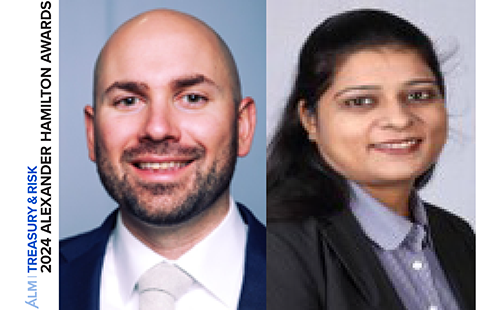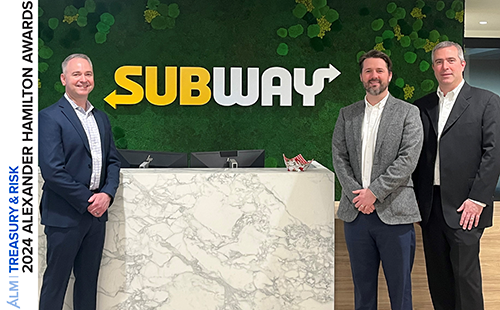
It’s not often that an $18 billion company spins up a treasury function from scratch, but that is exactly the challenge GE HealthCare Technologies faced when GE announced in 2021 that it would split into three separate enterprises. Ninety-five percent of treasury activities were centralized within the legacy GE organization. So as GE HealthCare launched itself as an independent business, treasury was a blank slate.
“At the time of the announcement, GE HealthCare did not have a dedicated treasury function,” says Aditi Agarwal, the global operations lead and chief of staff for treasury at GE HealthCare. “We had a one-year TSA [transition service agreement] with GE corporate, so that is the length of time we had to onboard a treasury team, establish new systems and processes, and make sure we could run our operations ourselves.”
Simply copying the treasury practices of GE corporate was not a good option. “GE treasury was a highly professional operation, but it was designed to support GE Capital, a $500 billion bank,” says Peter Claus-Landi, assistant treasurer in GE HealthCare’s global treasury operations group. “We needed to build more fit-for-purpose, focused processes and a right-sized technology stack that would be appropriate to a healthcare technology company.”
Recommended For You
GE HealthCare hired a corporate treasurer, Robert O’Keef, to serve as treasury employee number one. O’Keef immediately began a rigorous needs assessment in order to prioritize the new company’s treasury initiatives. As he built out his treasury group, the team held a series of structured, deep-dive workshops that leveraged the Lean methodology, tactical knowledge-sharing sessions, and less-formal exploratory conversations to understand all the key factors impacting GE HealthCare. They also worked on a “treasury 2028 vision” that defined which objectives would matter most for the treasury function over the next five years.
Through this process, GE HealthCare identified six core treasury workstreams that it needed to stand up within the first year:
- The corporate treasury workstream dealt with the company’s capital structure and ratings-agency interactions, capital markets, domestic and international funding, bank relationship management, cash flow forecasting, and pension management.
- The business treasury workstream covered global liquidity management, regional treasury operations, foreign exchange (FX) and commodity risk management, and treasury financial planning and analysis.
- The global treasury operations workstream included bank account management, global payments and settlements, treasury systems management, and trade finance.
- The risk management and insurance workstream included exposure analysis, loss prevention and mitigation, insurance negotiation and placement, and claims support and program administration.
- The risk workstream covered customer and counterparty credit risk management, operational risk assessment and control, and policy development and governance.
- And the order-to-cash workstream required design and oversight of the company’s global order-to-cash process, as well as development of best practices in working capital management.
“We took a very data-driven approach—from system, process, and people perspectives—when looking at how to build our treasury,” Claus-Landi says. “We would look at each of the different treasury processes we need to run, then build a plan around that process, depending on where we would need those capabilities throughout the world and which processes we would need to support. We started designing the organization that could best support day-to-day operations. And then we did benchmarking with some of our peers, with help from external treasury advisers.”
Technology selection was a key component of the journey to build out each treasury workstream. For every activity that treasury needed to perform, the new treasury team evaluated whether all the required capabilities were available within leading treasury management systems.

“The legacy GE corporate treasury organization used 36 major systems,” Agarwal says. “The infrastructure was designed to support GE businesses that were more complex than ours. We decided to keep a very tight focus on healthcare as we evaluated whether we really needed sophisticated homegrown applications like those used by GE corporate. Our objective was to consolidate our work where possible—preferably within SaaS [software-as-a-service] applications.”
The team chose to deploy FIS Treasury and Risk Manager–Quantum as their full-service treasury management system, with the FIS Payment Hub to centralize payments companywide and FIS eBAM to automate bank account management. AtlasFX provides FX risk management; 360T enables trades of FX and interest rate derivatives, along with other financial instruments; and GTC simplifies the company’s trade finance.
“As we gained more visibility into our cash flows and working capital, we also began to better understand how our collections model was working and what our payment cycle looked like,” Agarwal says. “All of treasury’s data became available within the treasury technology ecosystem, which made it much easier for us to tap into that data, do the analysis, and drive discussions with the business units around issues like whether we could change the payment cycle to enhance working capital.”
Meanwhile, the GE HealthCare treasury group was working to develop partnerships that would help them build out their function. The team established relationships with other internal functions, including technology, accounting, tax, HR, and legal, as well as the leadership teams in the company’s business segments. They also cultivated relationships with PwC Treasury Consulting, the company’s relationship banks, and numerous technology providers.
“At the end of the day, treasury can do data analysis, but the sales team or the sourcing team or the collections team has to actually do the work to achieve improvements,” Agarwal says. “We created cross-functional connections with different stakeholders and made sure that we can share valuable information, which helps the organization optimize both liquidity and working capital.” In developing these connections, the team established treasury as a leading partner to the business for enhancing and communicating shareholder value.
Utilizing all their newly available insights, the treasury team identified opportunities to release working capital and enhance the company’s free cash flow. They found areas in which in-house banking could reduce required cash balances. They finetuned FX exposure management to cut their FX trading volumes by about 25 percent. They also took a new approach to bank account management, and they expect to soon undertake an account rationalization initiative that will significantly reduce GE HealthCare’s number of bank accounts around the world.
————————————————————
See also:
————————————————————As the treasury team developed processes across all six of their core workstreams, they kept governance and controls top-of-mind. “Everything that we built had a controls mindset against it,” Claus-Landi says. “In addition, as we put together our risk-control matrix, we also put together an organization to test all the controls we put in place, just to make sure the treasury organization is operating in the most efficient way possible.”
Standing up a full-fledged treasury organization within one year was a daunting task. But collectively, with extensive planning and a lot of testing, the GE HealthCare treasury group was able to build a successful treasury organization within the 12-month timeline. When the TSA with GE expired, all the key workstreams for GE HealthCare treasury were functioning as envisioned. Still, the team is not resting on their laurels.
“Now we are going back and regularly looking at that 2028 vision we put into place,” Claus-Landi says. “We ask: ‘What have we accomplished so far? And what are we looking forward to over the next five years?’ This helps us prioritize incremental steps that treasury can take to continue optimizing.”
In fact, Agarwal adds, treasury recently introduced an event they called a ‘simplification marathon.’ “We asked the teams that are working on the ground to come up with ideas for what they want to change in their functions: Where do they see opportunities to simplify?” she says. “We received 42 ideas from the team, and we shortlisted 15 of them.”
As GE HealthCare’s treasurer, O’Keef has very deliberately built a continuous-improvement mindset into the company’s treasury organization. “He was extremely vested in creating the right culture for our new function,” Agarwal says. “Continuous improvement is a key element of the culture. We make sure that we keep going back to our five-year vision board and do introspection on our core values. And we keep asking ourselves as leaders, ‘Are we actually demonstrating the values that we set out for our organization?’ We take feedback from our teams and continue to work on that.
“Transformation is not a one-year project,” she concludes. “It’s a journey. There are many creative ways of completing treasury tasks, and as treasury professionals, we should continuously challenge ourselves to do things better.”

© Touchpoint Markets, All Rights Reserved. Request academic re-use from www.copyright.com. All other uses, submit a request to [email protected]. For more inforrmation visit Asset & Logo Licensing.



